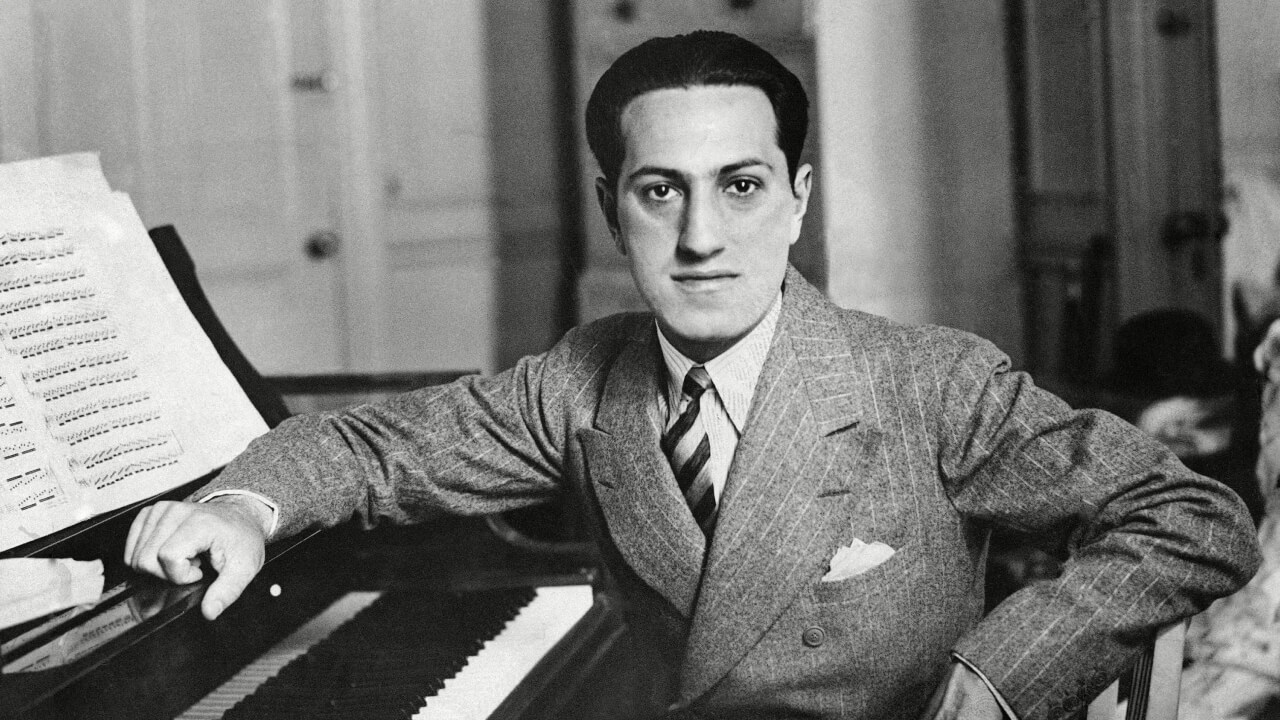A Life Cut Short, A Sound Unfinished
Most people hear “the day the music died” and think of that tragic plane crash in 1959. Buddy Holly, Ritchie Valens and the Big Bopper gone in an instant. But that was for rock n’roll. I’d argue a piece of George Gershwin’s legacy and America’s musical soul died way earlier. July 11, 1937, to be exact. This year marks 88 years since the day George Gershwin, just 38 years old, died of a brain tumor.

George Gershwin’s legacy wasn’t just a composer. He was a creative storm. A guy who built a bridge between jazz and classical, Broadway and opera, Harlem and Carnegie Hall. Gershwin and his music didn’t sit still. It moved, shimmered, danced, ached. I
t wasn’t just notes on a page… it was the sound of a country figuring out what it could be in a time when things were, well, complicated in America.
Think about it. “Rhapsody in Blue” is basically New York in audio form not just the United Airlines commercial (pick your poison, I guess). “An American in Paris” made Parisians wish they were American. “Porgy and Bess” gave us “Summertime,” sure, but it also gave us an opera centered on Black American life. And he wasn’t even 40. He died in the middle of a project that was never completed. He was gone before the war. Before bebop. Before Bernstein, Motown, and everything we now call iconic.
What stings even more is how little time he had. His classical catalog? Pretty short. This piece would be incomplete without mentioning my favorite piece, So Am I (1924)or Lullaby for Strings (1919). We’re talking about a few major orchestral pieces like Rhapsody in Blue, Concerto in F, Cuban Overture and, of course, Porgy and Bess. But that wasn’t just George Gershwin’s legacy. For solo piano, a handful of gems like the Three Preludes and his Songbook arrangements. That’s it. In under 20 years, he built the foundation for a whole new musical America. And then it just… stopped.
A City, A Stage, A Sound:
Gershwin in Los Angeles
When Gershwin died, we didn’t just lose a composer. We lost a vision and a possibility. A version of music where jazz and classical weren’t stuck in their own lanes. Gershwin moved between them like it was nothing. He could give you a Tin Pan Alley toe tapper in the morning and a full-blown symphony by night.

That impact was felt especially hard here in Los Angeles.
Speaking directly to Hollywoodland News, Derek Traub, historian and author of Hollywood Bowl: The First 100 Years, told us:
“While George Gershwin’s time in Los Angeles was tragically cut short, his impact here was profound. He personally coached American pianist Toska Tolces in the West Coast premiere of Rhapsody in Blue at the Hollywood Bowl in 1927, and a decade later played piano and conducted two all-Gershwin programs with the Los Angeles Philharmonic at Philharmonic Auditorium downtown. Gershwin had been planning a major concert at the Bowl for the summer of 1938 before his untimely death.”
Instead, that concert became a memorial, a star-studded tribute attended by over 22,000 people and broadcast to millions on CBS Radio. It was the most-listened-to broadcast in Bowl history. Ira Gershwin preserved the recording on rare transcription discs handed out only to George’s closest friends. That memorial wasn’t just a goodbye. It was a national moment of mourning and remembrance.
As Traub put it:
“The legacy of Gershwin and the legacy of the Bowl are deeply entwined… both celebrate what Principal Conductor Thomas Wilkins calls ‘no labels’ music: a bold, genre-defying spirit that defines the Bowl to this day.”
That same spirit lives on. On July 22, piano phenom Hayato Sumino—who went viral for his Royal Albert Hall performance—will make his LA Phil debut, playing Gershwin’s Rhapsody in Blue under the stars at the Bowl. It’s a full-circle moment that reminds us: Gershwin never really left the stage.
After he was gone, the split got wider. Jazz pushed boundaries and got freer. Classical music leaned hard into avant-garde. Broadway went big and commercial. But that sweet spot in between—the space where Gershwin lived, got lost.
Sure, a few tried to find it again. Bernstein had the skill. Ellington had the soul. But Gershwin had the moment. He had the guts to take syncopation and swagger into serious music and make it work.
george gershwin’s Legacy is both complicated but cultural
And yeah, it’s important to talk about the cultural context. Gershwin was a white man creating within a Black musical tradition. Jazz didn’t come from concert halls. It came from Black communities filled with soul, struggle and joy. Gershwin had access that many Black artists didn’t. That fact doesn’t erase his brilliance. It adds another layer to the story.
What made Gershwin different was how deeply he respected and loved the music. He didn’t just dabble in songwriting. He studied. He listened. He collaborated. He insisted on an all Black cast for Porgy and Bess and spent time in Charleston learning directly from Gullah communities. That kind of engagement was rare at the time and it sparked backlash.

There are different takes on Porgy and Bess. Some people see it as a cultural celebration. Others see it as a white lens on Black pain. Both views matter. Gershwin still worked to elevate a genre that many others used without respect. The conversation around his legacy should make space for that complexity.
Audra McDonald, the definitive voice of Bess for a generation, spoke to this in a 2011 interview with the Los Angeles Times:
And in a lot of the research that I’ve done on this piece, learning about the history of it, the many different versions of it that exist and will continue to exist and will continue to morph as this piece goes on into the 21st century, I know George Gershwin and DuBose Heyward were writing this piece from a place of love and from their understanding of African American culture. But they were still outsiders in that culture, and therefore they can’t possibly have perfectly drawn fine lines for their characters, because it’s an outside culture, especially at a time when there was no race mixing to speak of. And also it was a time when it was the law in many parts of the land that, yes, black people don’t come to the theater the same day as white people come to the theater in the Jim Crow South.

This year, Porgy and Bess turns 90. It premiered in 1935 with an all Black cast and told a story set in the South using spirituals, jazz and operatic form. (Also, Audra McDonald is the queen of this role and Broadway confirmed it.) Some called it the first great American opera while others challenged that title and the framing behind it.
It’s messy. It’s complex. The legacy of this musical is still evolving.
George Gershwin’s legacy isn’t just about what he wrote. It’s about what he made possible. He blended jazz, classical, Broadway and Black musical traditions into a sound that changed what American music could be.
Standing on Black Broadway’s Shoulders
To really understand where Porgy and Bess landed in the cultural timeline, you have to look at the shows that came before it and veer into some of my favorite history, BROADWAY HISTORY! Productions like Shuffle Along (1921) helped kick open Broadway’s doors to Black performers and creators. Written by Noble Sissle and Eubie Blake, that show was a game changer. It showed that an all Black musical could have commercial success and it was possible on a major stage.

Then came shows like Runnin’ Wild (1923), which introduced the Charleston dance craze to white audiences. Yes, that Charleston. The Chocolate Dandies (1924), also by Sissle and Blake, continued pushing Black artistry into the spotlight. And Hot Chocolates (1929), with music by Fats Waller and lyrics by Andy Razaf, gave us Louis Armstrong on Broadway and the timeless hit “Ain’t Misbehavin’.”

These productions weren’t just entertainment. They were essential to the Harlem Renaissance by bridging uptown culture and downtown stages, and helping redefine what Black performance could look and sound like on Broadway. So when Porgy and Bess arrived in 1935, it did so standing on the shoulders of Black creatives who had already transformed the game.
Miles Davis and Ella Fitzgerald recorded it. Opera companies keep staging it. Music scholars keep unpacking it. It is a force to be reckoned with but we can’t include at Hollywoodland News without acknowledging its roots.
George Gershwin’s Legacy:
The Greatest American Composer?
It’s okay to say that plenty of folks believe Gershwin is the greatest American composer. George Gershwin’s legacy isn’t just because he wrote catchy tunes but because he cracked something wide open that was missing from our cultural landscape.
Before Gershwin, American classical music borrowed its voice from Europe. After him, it started to sound like… US jazz, like cities, like rhythm and grit and beauty all tangled up together. He made it cool for concert halls to swing. He made critics take pop music seriously.
He didn’t just write songs. He wrote cultural landmarks. “Rhapsody in Blue” still soundtracks New York. “Summertime” has been recorded more than 25,000 times. “I Got Rhythm” became the building block for half of bebop.
He broke rules. He set trends. He didn’t wait for permission.
And yeah, his fingerprints are everywhere. You can hear Gershwin in film scores, hip-hop samples, jazz arrangements and symphonies. John Williams, early in his career, recorded Gershwin’s “Fascinatin’ Rhythm” on his 1961 album Rhythm in Motion. It was his own little nod to the guy who made blending styles a whole-ass art form.

Williams doesn’t talk about it much, but listen closely and you’ll hear it in the melodies, in the swagger and in the cinematic build.
From Stevie Wonder to Alicia Keys to Jon Batiste, that same fearless spirit lives on.
So sure, February 3, 1959 might be the day rock and roll cried. But July 11, 1937? That was the day American music lost its bravest rule-breaker.

And maybe that’s why George Gershwin’s legacy still lingers. Not just because he wrote beautiful music but because he believed something wild and brave and that jazz and classical and every flavor of America could live together in one sound. One voice. One future.
And when he died, that future dimmed a little too.
And for those still wondering what makes Gershwin’s legacy different? Just ask the people who’ve spent a lifetime immersed in his work.
In a statement provided exclusively to Hollywoodland News, Bill Elliott, Tony Award–winning arranger and orchestrator of An American in Paris, reflected on George Gershwin’s legacy:
I am grateful to have lived in a time when Gershwin’s music was widely celebrated and available to enjoy and study. I was fascinated by his music at an early age, and I’ve gotten to know it intimately and deeply in my professional career as an arranger and orchestrator. I have returned to his music in times of disillusionment or despair, and I’ve always found my spirits restored. Like our image of him as a person—the charming, energetic young man who could delight and astonish us at the piano—his music is forever young.
That’s the magic. Gershwin isn’t just a legacy. He’s a lifeline.
Quote source:
Audra McDonald, interview with Irene Lacher, Los Angeles Times, October 5, 2011. Read the original article




Leave a Reply